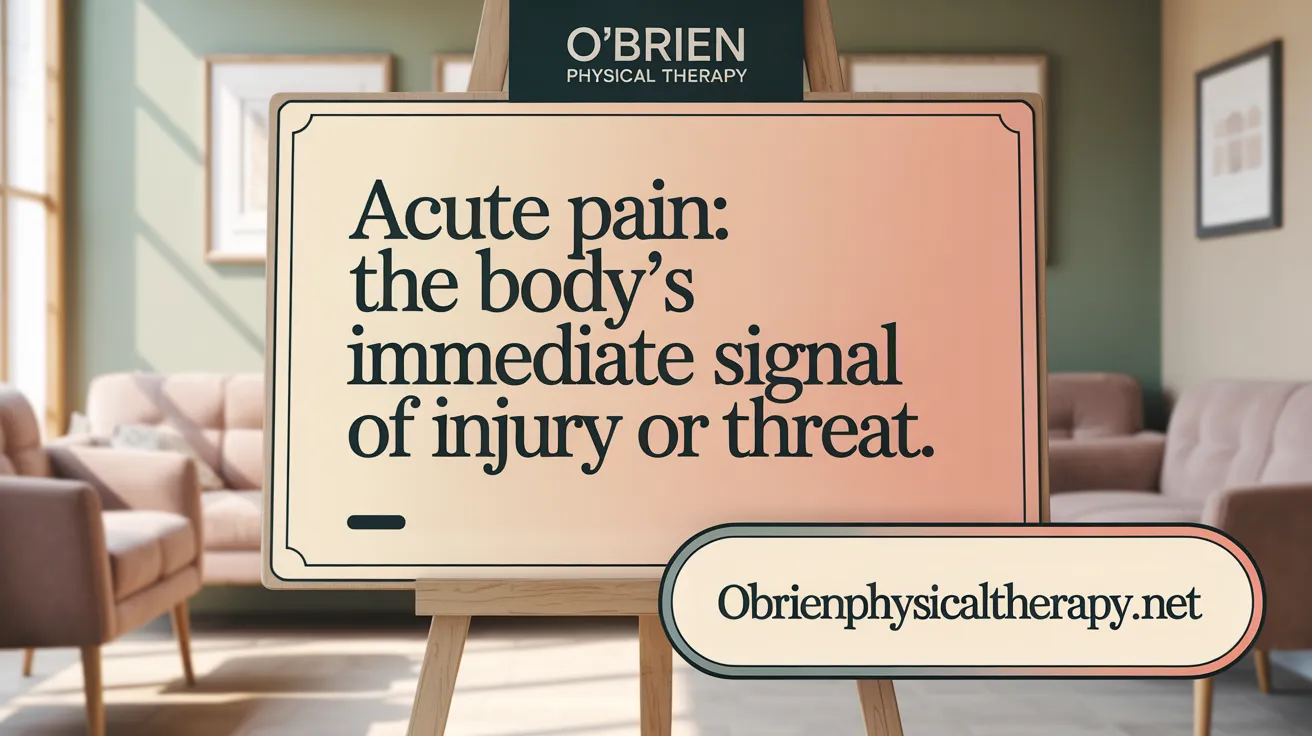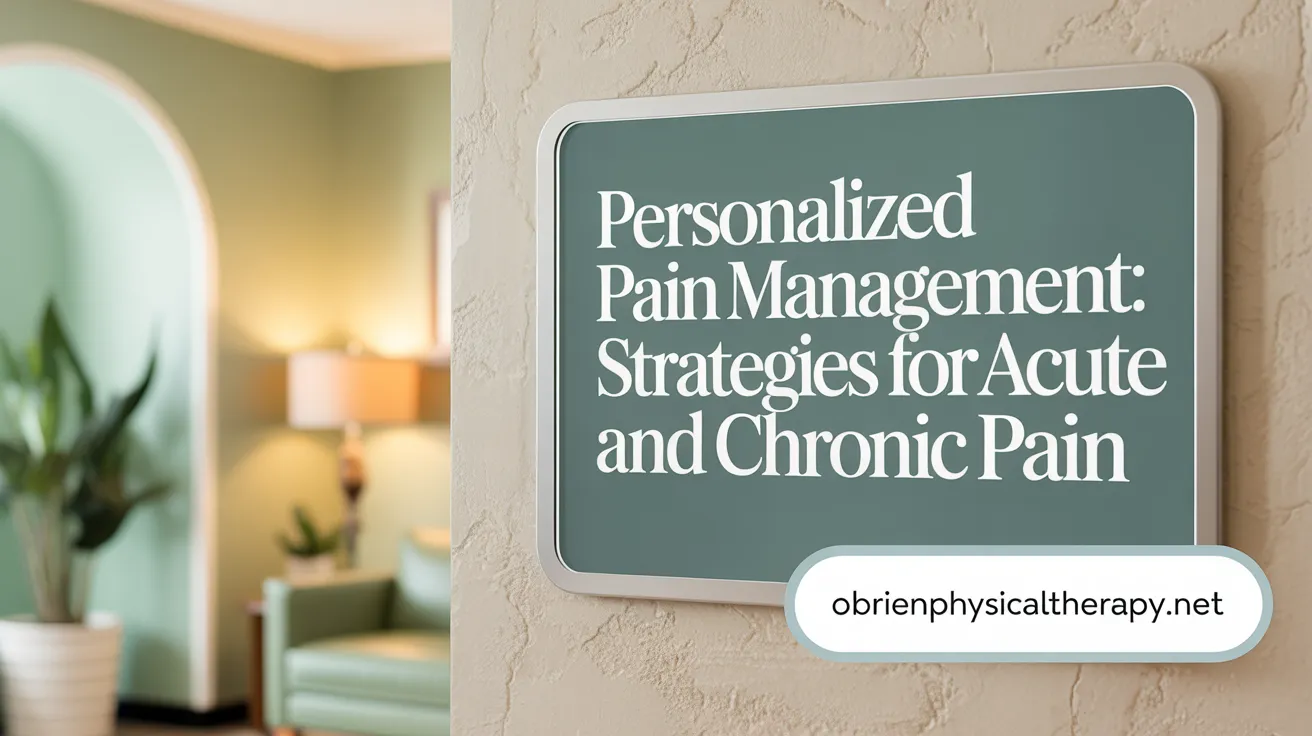Pain: An Ever-Present Human Experience
Pain is a universal sensation that alerts us to injury or illness, playing a crucial role in human survival. However, not all pain is created equal. Understanding the fundamental differences between acute and chronic pain is essential in recognizing the body’s signals, determining appropriate care, and improving quality of life. This article explores the characteristics, causes, diagnosis, and management of acute and chronic pain, delving into the complexities that distinguish one from the other.
Defining Acute Pain: The Body’s Immediate Alarm

What characterizes acute pain and what causes it?
Acute pain starts suddenly and is directly linked to specific injuries or illnesses. Typical causes include broken bones, burns, cuts, surgery, dental procedures, dislocated joints, illness-related discomfort, childbirth, and kidney stones. This type of pain acts as an immediate warning sign to the body that something harmful has occurred, signaling tissue damage or potential threat (acute pain causes, acute pain characteristics, What is Acute Pain?).
Definition and duration of acute pain
Acute pain generally lasts less than three to six months. It is transient and typically resolves once the underlying problem heals or is adequately treated (Chronic pain characteristics, Acute vs Chronic Pain Overview).
Physiological purpose and symptoms
Serving a protective role, acute pain helps the body avoid further injury by prompting reflexive actions or rest. Symptoms often include sharp, stabbing, burning, or throbbing sensations localized to the injury site, which can also cause muscle spasms or numbness (acute pain characteristics, Symptoms of acute pain, acute pain overview).
How is acute pain diagnosed and treated?
Diagnosis involves a detailed patient history and physical examination, complemented by pain rating tools such as the Wong-Baker FACES scale. When needed, imaging tests like X-rays, MRI, CT scans, ultrasounds, blood work, or nerve conduction studies help identify causes (Diagnosing acute pain, Pain assessment tools, Diagnostic tests for acute pain.
Treatment primarily targets the underlying cause and pain relief. Rest, ice, compression, and elevation (RICE) are common initial steps (RICE Method for Acute Pain. Medications like nonsteroidal anti-inflammatory drugs (NSAIDs) and acetaminophen are first-line. Muscle relaxants and topical treatments can also alleviate symptoms (Pharmacologic therapy for acute pain, Medications for Acute Pain. Physical therapy supports recovery, while massage and acupuncture offer complementary benefits (Physical Therapy for Acute Pain, psychological therapies in pain management). Opioids are reserved for severe or resistant pain within a multimodal strategy to minimize risks (opioid use in acute pain, Acute Pain Management).
This structured approach ensures prompt relief and reduces the risk of pain becoming chronic (Managing acute pain, Preventing chronic pain progression).
Understanding Chronic Pain: When the Alarm Continues

What distinguishes chronic pain from acute pain in terms of duration and cause?
Chronic pain is characterized by its persistence beyond three to six months, often continuing long after the initial illness or injury has healed. Unlike acute pain, which is sudden and linked to a specific injury or event, chronic pain may also develop without a clear cause and is sometimes viewed as a disease state itself. Approximately 20-25% of adults experience chronic pain, resulting from conditions such as arthritis, fibromyalgia, back and neck injuries, neuropathies, cancer-related pain, endometriosis, migraines, and complex regional pain syndrome (CRPS). For more detailed information, see Difference Between Acute and Chronic Pain.
What are the symptoms and broader impacts of chronic pain?
Symptoms of chronic pain include ongoing aching, burning, shooting sensations, stiffness, throbbing, and heightened sensitivity to touch. This persistent pain often accompanies fatigue, insomnia, anxiety, depression, and mood swings. The complex interplay of these symptoms can severely affect daily functioning, limiting mobility, compromising work performance, straining relationships, and eroding mental health. Often referred to as the "terrible triad," the combination of chronic pain, depression, and irritability can lead to disrupted sleep, amplify pain perception, and deepen emotional distress. You can learn more about the effects of chronic pain and its management in Chronic pain overview and Chronic Pain Syndrome symptoms.
How is chronic pain diagnosed and managed?
Diagnosing chronic pain involves a thorough review of the patient's medical history and a physical examination to characterize pain type and severity. Diagnostic tools such as MRI, CT scans, blood tests, and nerve conduction studies help identify underlying causes. Psychological screening is crucial to detect comorbidities like depression and anxiety, which can influence pain outcomes.
Management of chronic pain demands a multidisciplinary strategy. Pharmacologic treatments may include NSAIDs, acetaminophen, certain antidepressants, anticonvulsants, muscle relaxants, and opioids used cautiously due to addiction risks. Physical therapy enhances mobility and function, while psychological therapies in pain management, like cognitive behavioral therapy, address mental health aspects. Complementary treatments such as acupuncture and massage can provide additional relief. In select cases, medical procedures—nerve blocks and surgery—may be necessary. Success in chronic pain care depends on individualized plans that incorporate lifestyle adjustments and long-term coping techniques to improve quality of life. For comprehensive details on diagnosis, treatment options, and management strategies, see Chronic pain management, Treatment options for chronic pain, and Multidisciplinary Approach to Chronic Pain.
The Nervous System’s Role: From Protection to Persistent Pain

How does the nervous system differentiate acute from chronic pain?
Acute pain begins with receptor nerve cells that detect tissue damage, sending signals that alert the body to immediate danger. This pain prompts protective responses like withdrawal or rest, helping prevent further injury. Once the cause heals, these pain signals typically stop (Acute Pain Characteristics.
In contrast, chronic pain involves complex changes in the nervous system, including peripheral and central sensitization. Here, nerves become overactive or hypersensitive, causing the brain to perceive pain continuously even after tissues have healed. This results in a “broken alarm” effect, where pain persists without ongoing physical damage.
What types of pain are involved and how do psychological and social factors affect the pain experience?
Pain can be classified into three main types:
- Nociceptive pain: due to actual tissue damage or inflammation.
- Neuropathic pain: resulting from nerve injury or dysfunction.
- Nociplastic pain: pain from altered nervous system processing without clear tissue injury.
Psychological factors such as fear, anxiety, depression, and coping skills deeply influence how pain is experienced and managed. For instance, negative emotions can amplify pain perception, while effective coping can lessen it (Pain Perception and Psychological Factors).
Social determinants—including environment, healthcare access, emotional support, and social disparities—also play critical roles. These factors impact not only the pain intensity but also the success of treatment and recovery (Pain and Social Determinants.
Understanding pain as a biopsychosocial experience highlights the importance of addressing biological mechanisms alongside psychological and social influences to better manage both acute and chronic pain.
Comparative Management Strategies: Tailoring Treatment to Pain Type

What are the key differences in managing acute versus chronic pain?
Acute pain management focuses on swift relief and healing by targeting the underlying cause. Typical strategies include rest, the RICE method (rest, ice, compression, elevation), use of anti-inflammatory and analgesic medications such as NSAIDs and acetaminophen, physical therapy, and sometimes minor procedures. Opioids may be prescribed but only for severe cases and for brief periods to minimize risks (Opioid use in acute pain).
Chronic pain management, on the other hand, involves a long-term, comprehensive approach. It combines medications including NSAIDs, acetaminophen, antidepressants, anticonvulsants, and cautiously prescribed opioids when necessary (Medications for chronic pain). Treatment extends beyond medications to include physical and psychological therapies in pain management, lifestyle modification, medical devices, surgical options, and complementary modalities (Chronic pain treatment approaches). Since chronic pain often results from nervous system hypersensitivity, management aims to improve quality of life rather than cure (Nerve Hypersensitivity in Chronic Pain.
What role do non-pharmacologic and integrative therapies play in pain management?
Non-pharmacologic treatments are essential in managing both acute and chronic pain. These include physical therapies like exercise, stretching, and spinal manipulation that help restore function and decrease pain (Physical therapy for pain, Movement therapy for pain). Mind-body practices such as yoga, tai chi, and mindfulness meditation reduce pain perception and improve coping (Mindfulness and pain management).
Complementary treatments like acupuncture and massage therapy serve to relax muscles, improve circulation, and reduce discomfort (Benefits of massage therapy, Acupuncture for chronic pain. Psychological therapies in pain management, particularly cognitive behavioral therapy, address the emotional and mental aspects of pain, helping patients manage anxiety, depression, and stress associated with chronic conditions (Psychological therapies for pain, Cognitive behavioral therapy).
The best outcomes arise from personalized, multidisciplinary plans coordinated by healthcare teams. These plans recognize pain’s complex biological, psychological, and social influences and aim to optimize function, reduce reliance on medications, and enhance overall wellbeing (Multidisciplinary Approach to Chronic Pain, Multidisciplinary pain management).
The Importance of Early Intervention and Long-Term Care

Why is early and effective treatment of acute pain critical?
Early intervention in acute pain management is vital to promote healing and prevent complications. Properly treating acute pain enables faster recovery and early mobilization, reducing risks like venous thromboembolism and pneumonia. Moreover, effective acute pain management lowers the likelihood of the pain becoming chronic, which can result in prolonged suffering and diminished quality of life.
How do mental health issues interplay with chronic pain, and why is a multidisciplinary approach necessary?
Chronic pain often coexists with mental health conditions such as depression and anxiety, which can worsen pain intensity and decrease responsiveness to treatments. These psychiatric comorbidities significantly impact a person's physical and emotional wellbeing. Managing chronic pain effectively requires a multidisciplinary team approach—bringing together physicians, physical therapists, psychologists, and other health professionals—to address both the physical symptoms and psychological aspects for comprehensive care.
What role does patient education and provider-patient communication have in outcomes?
Patient education empowers individuals by improving their understanding of pain mechanisms and self-management techniques. When healthcare providers validate patients’ pain experiences and foster trust, adherence to treatment plans increases, and emotional distress decreases. Open communication that considers biological, psychological, and social factors ensures therapies are tailored to individual needs, enhancing overall pain control and quality of life.
Bridging Understanding and Care for Pain
Recognizing the distinctions between acute and chronic pain is critical for effective diagnosis, treatment, and improving patients’ lives. Acute pain, as a protective and temporary signal, requires prompt management to prevent complications and promote healing. Chronic pain, often complex and multifaceted, demands a comprehensive, interdisciplinary approach that addresses physical, psychological, and social dimensions. Increased awareness, patient education, and collaborative care are essential in managing pain effectively and compassionately, ensuring that the diverse experiences of pain receive the attention and treatment they require. With ongoing research and evolving therapies, there is hope for better outcomes and enhanced quality of life for those enduring acute or chronic pain.
